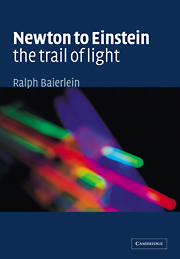 Newton to Einstein: The Trail of Light
Newton to Einstein: The Trail of Light Published online by Cambridge University Press: 05 June 2012
Even the Rays of Light seem to be hard bodies; for otherwise they would not retain different Properties in their different Sides.
Isaac Newton, Query 31, OpticksTheory building
By now we have a substantial number of observations; we know quite a bit about how light behaves. Let us try our hand at building a theory of light: what light is, and why it behaves as it does.
Our first observation – that light goes in straight lines from a luminous source – suggests that we need the notion of something that moves through space. The simplest thing is a particle, a “little baseball.” Perhaps the luminous source emits little light particles, a stream of them. Figure 2.1 illustrates this notion.
Isaac Newton developed the same idea. He worked on light – experimentally and theoretically – most of his long life. At the start of chapter 1, we noted that Newton's first paper (published in 1672) was on optics, and his interest in the subject goes back at least to his student days at the University of Cambridge, England, perhaps to the year 1663.
Newton could not abide criticism, and so he went to great lengths to avoid even the possibility of it. Because Robert Hooke and he readily came to acrimonious disagreement, Newton withheld the publication of his book on optics until after Hooke's death. Finally, in 1704, Newton published his treatise Opticks.
To save this book to your Kindle, first ensure [email protected] is added to your Approved Personal Document E-mail List under your Personal Document Settings on the Manage Your Content and Devices page of your Amazon account. Then enter the ‘name’ part of your Kindle email address below. Find out more about saving to your Kindle.
Note you can select to save to either the @free.kindle.com or @kindle.com variations. ‘@free.kindle.com’ emails are free but can only be saved to your device when it is connected to wi-fi. ‘@kindle.com’ emails can be delivered even when you are not connected to wi-fi, but note that service fees apply.
Find out more about the Kindle Personal Document Service.
To save content items to your account, please confirm that you agree to abide by our usage policies. If this is the first time you use this feature, you will be asked to authorise Cambridge Core to connect with your account. Find out more about saving content to Dropbox.
To save content items to your account, please confirm that you agree to abide by our usage policies. If this is the first time you use this feature, you will be asked to authorise Cambridge Core to connect with your account. Find out more about saving content to Google Drive.